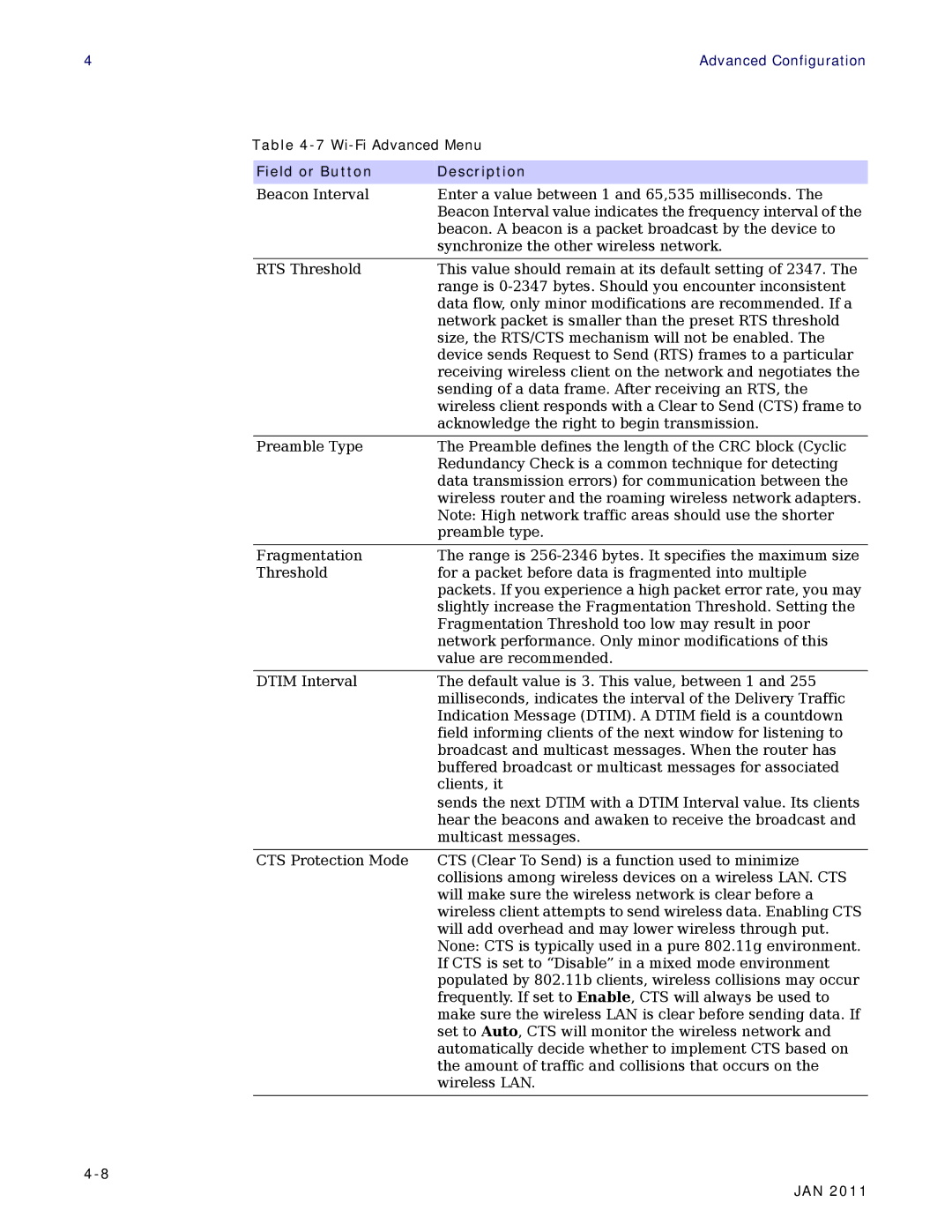4 | Advanced Configuration |
Table
Field or Button | Description |
Beacon Interval | Enter a value between 1 and 65,535 milliseconds. The |
| Beacon Interval value indicates the frequency interval of the |
| beacon. A beacon is a packet broadcast by the device to |
| synchronize the other wireless network. |
|
|
RTS Threshold | This value should remain at its default setting of 2347. The |
| range is |
| data flow, only minor modifications are recommended. If a |
| network packet is smaller than the preset RTS threshold |
| size, the RTS/CTS mechanism will not be enabled. The |
| device sends Request to Send (RTS) frames to a particular |
| receiving wireless client on the network and negotiates the |
| sending of a data frame. After receiving an RTS, the |
| wireless client responds with a Clear to Send (CTS) frame to |
| acknowledge the right to begin transmission. |
|
|
Preamble Type | The Preamble defines the length of the CRC block (Cyclic |
| Redundancy Check is a common technique for detecting |
| data transmission errors) for communication between the |
| wireless router and the roaming wireless network adapters. |
| Note: High network traffic areas should use the shorter |
| preamble type. |
|
|
Fragmentation | The range is |
Threshold | for a packet before data is fragmented into multiple |
| packets. If you experience a high packet error rate, you may |
| slightly increase the Fragmentation Threshold. Setting the |
| Fragmentation Threshold too low may result in poor |
| network performance. Only minor modifications of this |
| value are recommended. |
|
|
DTIM Interval | The default value is 3. This value, between 1 and 255 |
| milliseconds, indicates the interval of the Delivery Traffic |
| Indication Message (DTIM). A DTIM field is a countdown |
| field informing clients of the next window for listening to |
| broadcast and multicast messages. When the router has |
| buffered broadcast or multicast messages for associated |
| clients, it |
| sends the next DTIM with a DTIM Interval value. Its clients |
| hear the beacons and awaken to receive the broadcast and |
| multicast messages. |
|
|
CTS Protection Mode | CTS (Clear To Send) is a function used to minimize |
| collisions among wireless devices on a wireless LAN. CTS |
| will make sure the wireless network is clear before a |
| wireless client attempts to send wireless data. Enabling CTS |
| will add overhead and may lower wireless through put. |
| None: CTS is typically used in a pure 802.11g environment. |
| If CTS is set to “Disable” in a mixed mode environment |
| populated by 802.11b clients, wireless collisions may occur |
| frequently. If set to Enable, CTS will always be used to |
| make sure the wireless LAN is clear before sending data. If |
| set to Auto, CTS will monitor the wireless network and |
| automatically decide whether to implement CTS based on |
| the amount of traffic and collisions that occurs on the |
| wireless LAN. |
|
|
JAN 2011
